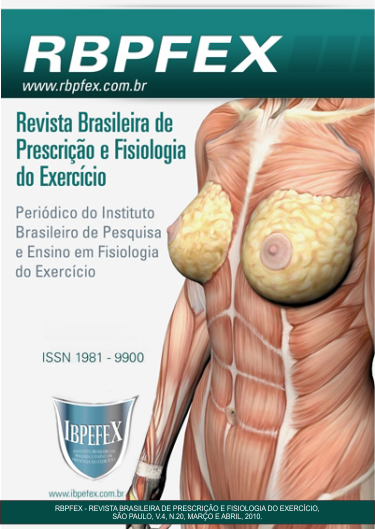Tai Chi Chuan and health in elderly
Abstract
The purpose of this article was to summarize the results showed in the literature that relates Tai Chi Chuan (TCC) and health, aiming at giving some direction for future research and interventions. Thus, the bibliographical base MedLine was consulted. The key words that were used were “Tai Chi Chuan” as well as filtered with the combination “Tai Chi Chuan + Health”. This revision started with a number of 369 articles on Tai Chi Chuan. After the first selection, which took into consideration the results of the combination “Tai Chi Chuan + Health”, 183 remained, which then were manually selected taking into account their relevance for this study, in relation to the questions considered for the analysis (being written in English; dealing with the subject of Tai Chi Chuan and health; studies that approached psychic or mental illnesses had not been considered; those ought to have been done with citizens above 55 years old; they also ought to have clearly determined their studied age-group; they should have been published between 2004 and 2009). At the end of this study, seven papers remained d those were analyzed. A total of 780 subjects had been evaluated in the literature review considering that among these 252 were men and 475 were women, 191 subjects had not had the sex discriminated in the research. The Tai Chi Chuan, according to the analyzed data, is a potentially efficient physical activity for the maintenance and improvement of the physical functions, such as the body balance and proprioception and neuromuscular reaction in elderly people, therefore, being one efficient form of falling prevention in this public.
References
- Brown, D.D.; Mucci, W.G.; Hetzler, R.K.; Knowlton, R.G. Cardiovascular and ventilatory responses during formalized Tai Chi Chuan exercise. Research in Exercise and Sports. Num. 60. 1989. p. 246–250.
- Camarano, A. A. Envelhecimento da população Brasileira: uma contribuição demográfica. Ministério do planejamento, orçamento e gestão. Rio de Janeiro, janeiro de 2002. Disponível em: <http://www.ipea.gov. br>.Acessado em: 29 Jun. 2008.
- Ecclestone, N.A.; Myers, A.M.; Paterson, D.H. Tracking older participants of twelve physical activity classes over a three-year period. Journal of Aging and Physical Activity. Num. 6. 1998. p. 70-82.
- Frasen, M.; Nairn, L.; Winstanley, J.; Lam, P. Physical activity osteoarthritis management: A randomized controlled clinical trial evaluating Hydrotherapy or Tai Chi classes. Arthritis & Rheumatism. Vol. 57. Num. 3. 2007. p. 407-414.
- Gomes, L.; Pereira, M.M.; Assumpção, L.O.T. TAI CHI CHUAN: nova modalidade de exercício para idosos. Revista Brasileira Ciência e Movimento. Vol. 12. Num. 4, 2004. p. 89-94.
- Hong, Y.; Li, J.X.; Robinson, P.D. Balance control, flexibility and cardiorespiratory fitness among older Tai Chi practioners. Journal Sports Medicine. Num. 34. 2008. p. 29-34.
- Lee, M.; Lee, E.; Jonhnstone, J. Tai Chi for Health. São Paulo: Pensamento, 1989.
- Li, F.; Harmer, P.; Glasgow, R.; Mack, K.A.; Sleet, D.; Fisher, J.; Kohn, M.A.; Millet, L.M.; Mead, J.; Xu, J., Lin, M.; Yang, T.; Sutton, B.; Tompkins, Y. Translation of an effective intervention into a community-based falls – prevention program. American Journal Public Health. Num. 98. 2008. p. 1192-1198.
- Li, J.X.; Hong, Y.; Chan, K.M. Tai chi: physiological characteristics and beneficial effects on health. Br J Sports Med. Num. 35. 2001. p. 148–156.
- Oliveira, R.F.; Matsudo, S.M.; Andrade, D.R.; Matsudo, V.K.R. Efeitos do treinamento de Tai Chi Chuan na aptidão física de mulheres adultas e sedentárias. Rev. Bras. Ciên. e Mov. Vol. 9. Num. 3. 2001. p. 15-22.
- Pei, Y.; Chou, S.; Lin, P.; Lin, Y.; Hsu, T.; Wong, A. Eye-hand coordination of elderly people who practice Tai Chi Chuan. Journal Formosan Medical Association. Vol. 107. Num. 2. 2008. p. 103-110.
- População jovem no Brasil: a dimensão demográfica. Disponível em: <http://www.ibge.gov.br/home/estatistica/populacao/populacao_jovem_brasil/comentario1.pdf>. Acesso em: 29 Jun. 2008.
- Wong, A.M.; Lin, Y-C.; Chou, S-W.; Tang, F-T.; Wong, P-Y. Coordination exercise and postural stability in elderly people: effect of Tai Chi Chuan. Arch Phys Med Rehabil. Num. 82. 2001. p. 608-612.
- Thornton, E.W; Sykes, K.S.; Tang, W.K. Health benefits of Tai Chi exercise: improved balance and blood pressure in middle-aged women. Health Promot Int. Mar; Vol. 19. Num. 1. 2004. p. 33-38.
- Woo, J.; Hong, A.; Lau, E.; Lynn, H. A randomised trial of Tai Chi and resistence exercise on bone health, muscle strength and balance in commuunity-living elderly people. Age and Aging. Num. 36. 2007. p. 262-268.
- Xu, D.; Hong, Y.; Li, J.; Chan, K. Effect of Tai Chi exercise on proprioception of ankle and knee joints in old people. Journal Esports Medicine. Num. 38. 2004. p. 50-54.
- Xu, D.; Li, J.; Hong, Y. Effect of regular Tai Chi and jogging exercise on neuromuscular reaction in older people. Age and Aging. Num. 34. 2005. p. 439-444.
Authors who publish in this journal agree to the following terms:
- Authors retain the copyright and grant the journal the right of first publication, with work simultaneously licensed under the Creative Commons Attribution License BY-NC which allows the sharing of the work with acknowledgment of the authorship of the work and initial publication in this journal.
- Authors are authorized to enter into additional contracts separately for non-exclusive distribution of the version of the work published in this journal (eg, publishing in institutional repository or book chapter), with acknowledgment of authorship and initial publication in this journal.
- Authors are allowed and encouraged to post and distribute their work online (eg, in institutional repositories or on their personal page) at any point before or during the editorial process, as this can bring about productive change as well as increase impact and impact. citation of published work (See The Effect of Free Access).






